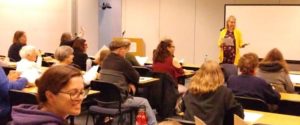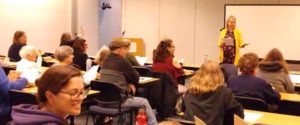Examining the Truth in Your Writing

Johnson leads a writing workshop at the library.
Writers are often encouraged to speak our truth. What does it mean to share our truth in our writing? At a recent writing workshop poet Melissa Fite Johnson and other writers discussed the meaning of truth and explored how it applies to our writing.
Johnson believes poetry and fiction can be powerful vehicles to help us convey meaning beyond the facts of a true story. In other words, writing around the truth helps us convey the impact of the truth. By telling a story readers will emotionally connect with, we can help readers feel and experience the truth.
The Line Between Truth & Story
Johnson used writing from Tim O’Brien as an example. O’Brien notes that “story-truth is truer sometimes than happening-truth.” In the following excerpt, O’Brien discusses the thin line between truth and story:
“Good Form” from The Things They Carried by Tim O'Brien:It’s time to be blunt.
I’m forty-three years old, true, and I’m a writer now, and a long time ago I walked though Quang Ngai Province as a foot soldier.
Almost everything else is invented.
But it’s not a game. It’s a form. Right here, now, as I invent myself, I’m thinking of all I want to tell you about why this book is written as it is. For instance, I want to tell you this: twenty years ago I watched a man die on a trail near the village of My Khe. I did not kill him. But I was present, you see, and my presence was guilt enough. I remember his face, which was not a pretty face, because his jaw was in his throat, and I remember feeling the burden of responsibility and grief. I blamed myself. And rightly so, because I was present.
But listen. Even that story is made up.
I want you to feel what I felt. I want you to know why story-truth is truer sometimes than happening-truth.
Here is the happening-truth. I was once a soldier. There were many bodies, real bodies with real faces, but I was young then and I was afraid to look. And now, twenty years later, I’m left with faceless responsibility and faceless grief.
Here is the story-truth. He was a slim, dead, almost dainty young man of about twenty. He lay in the center of a red clay trail near the village of My Khe. His jaw was in his throat. His one eye was shut, the other eye was a star-shaped hole. I killed him.
What stories can do, I guess, is make things present.
I can look at things I never looked at. I can attach faces to grief and love and pity and God. I can be brave. I can make myself feel again.
“Daddy, tell the truth,” Kathleen can say, “did you ever kill anybody?”
And I can say, honestly, “Of course not.”
Or I can say, honestly, “Yes.”
Powerful stuff. After reading this excerpt as a group, Johnson pointed out that O’Brien does not have children. This passage reads like an essay discussing “happening-truth” vs. “story-truth” and makes the point that both are honest. However, O’Brien is using fiction as a frame. In this example, Kathleen is a device that helps us frame the question of truth in storytelling and writing in a way that has an emotional impact and makes sense of the question.
Slanting the Truth
Another reason to frame our truth in story is found in the work of poet Emily Dickinson. Her poem “Tell all the Truth but tell it slant” encourages us to take a circuitous route to telling the truth, so we “dazzle gradually.” In other words, sometimes full-on truth is too much, too shocking. Our readers might shy away, or they might not believe it.
Have you ever heard that truth is stranger than fiction? Sometimes we need to change details to create something our readers will believe and connect with in the moment, on the page. Using fiction or poetry to tell our truth, but slant, sometimes gets us closer to our goal of sharing a story and making an emotional impact than a pure accounting of the truth. Hard truth can be a bit too much for the writer, too, especially if we're writing about traumatic events. Stepping back and looking at our experience through the eyes of a fictional character could give us the perspective we need to craft a story.
Time to Create Perspective
Time is another way to create perspective when crafting work from true events. Johnson recommends journaling to capture thoughts and details on paper. After some time passes, it is easier to craft that experience into good writing. She references Natalie Goldberg's Writing Down the Bones:
Our senses by themselves are dumb. They take in experience, but they need the richness of sifting for a while through our consciousness and through our whole bodies. I call this “composting.” Our bodies are garbage heaps: we collect experience, and from the decomposition of the thrown-out eggshells, spinach leaves, coffee grinds, and old steak bones of our minds come nitrogen, heat, and very fertile soil. But this does not come all at once. It takes time. Continue to turn over and over the organic details of your life until some of them fall through the garbage of discursive thoughts to the solid ground of black soil.
Or, as our Poet Laureate of Kansas, Huascar Medina recently said: "Be honest with your work and yourself. Let it have emotion. Write it … be raw about it at first; you can go back and clean it up, you know. Let it all out."
Melissa Fite Johnson kindly shared her packet from this workshop. Check out her excerpts from nonfiction, fiction and poetry. She also has a number of excellent writing prompts to help you examine the use of truth in your own writing.












